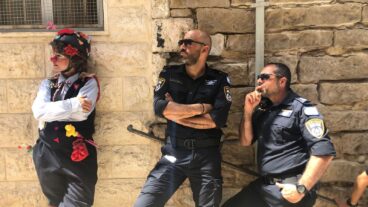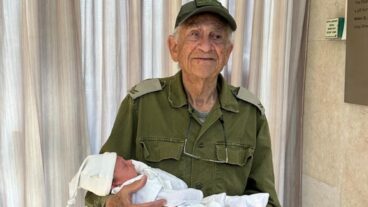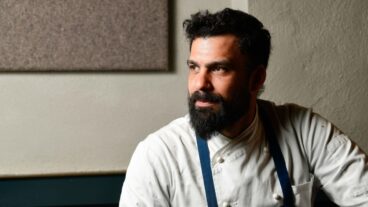“If you want to compete in the world, you have to start from the bottom,” nuclear physicist Harry Lipkin.Octogenarian Israeli nuclear physicist Harry Lipkin is not your ordinary scientist. Sure, he can easily talk about neutrino oscillations, quarks, and mesons, but he’s equally adept concerning his other passion – reading education.
The Weizmann Institute of Science professor emeritus gets to the core of the problem in education.
“Reading is the bottleneck,” he told ISRAEL21c at his home in Rehovot before leaving for an annual multi-month stint at the Argonne National Research Labs in Chicago. “A child entering first grade with the ability to speak and understand, has in his brain an information processing system far superior to anything in Silicon Valley. But a child’s learning to read can be compared to an astro-physicist looking for the keys to the cosmos. Both are trying to push the frontiers of their individual knowledge.”
Lipkin’s solution is a system of reading called LITAF, which was developed by Israeli educator Nira Altalef. The main feature of the system is the use of frequent simple diagnostic tests that enable the teacher to track a pupil’s progress in real time. “If the pupil stumbles, a teacher immediately puts him or her back on track,” says Lipkin who has become LITAF’s biggest fan, and launched a second career for him.
Lipkin, a young 86, knows a thing or two about careers. With a degree in electronic engineering and additional courses in physics, he nailed down his first job – the super secret microwave lab at MIT.
“I was part of the team that developed the first microwave radar receiver used to detect and eliminate German submarines off the Atlantic Coast in WWII,” Lipkin recalls.
As a graduate student Lipkin earned his PhD in nuclear physics at Princeton in 1946, rubbing shoulders with Niels Bohr and David Bohm, and observing how the master scientists tackled the enigmas of nuclear energy.
Exposed at Princeton to an agricultural training program run by Israeli kibbutz youth movement Hashomer Hatzair, Lipkin was attracted by the pioneer spirit, and in 1950 moved to Israel with his young wife Malka.
His professional expertise didn’t remain a secret however, and he was recruited to consult on the planned Dimona nuclear reactor. He and two other scientists were sent to Paris to learn what a nuclear reactor was and how it works, a project which lasted until 1957.
Upon his return to Israel, he joined the Weizmann Institute and worked to build a graduate school of nuclear physics, and establish Quantum mechanics and nuclear physics as requirements. It was around this time that he started becoming interested in reading education.
“If you want to compete in the world, you have to start from the bottom. At the time, only a small percentage of Israeli high school students were continuing to higher education,” he recalls. But it was decades later until he found a kindred spirit in Altalef, who in the 1980s was an advisor on special education for the upscale academically oriented Herzliya Gymnasium high school.
In the 1980s, Altalef was asked to evaluate the learning disabilities of children in the poor Hatikva neighborhood of Tel Aviv. The principals of two schools were desperate after years of failure. The breakdown of discipline, absenteeism, and vandalism were negative spin offs of lack of achievement.
She saw that the student’s inability to achieve was not a matter of intelligence; they could not achieve because they did not know how to read.
The LITAF system, based on the principles of Piagt, uses 30-40 familiar words in a child’s spoken language to start. To teach Arabic, 90 words are the core of the “memory support” method. The word “shalom” in Hebrew is the first.
In LITAF, the child learns how the word is broken down into syllables, and how syllables can be combined into other words. In a six-stage process, the child learns to identify all the consonants and vowels, and to build new words using them. The 7th stage is the development of fluent and accurate reading of new texts. At each stage the child gains a sense of achievement, the magic pill that reinforces his/her motivation to continue to take on new tasks.
“You don’t have to be a super teacher,” said Lipkin. Considering the fact that there are usually 40 heterogeneous pupils in a first-grade class in Israel, one would tend to think that the teacher has an impossible task. Not so. The class is divided up into groups of four or five, the teacher works with one group at the board at a time, and gives the others work pages or individualized tasks.
The flexible, structured curriculum includes a variety of interesting and challenging activities (e.g. using cubes with syllables and cutouts) so that each student is busy and advances at his own pace. This includes children with dyslexia. “Only 2% need a special class,” says Lipkin.
More than 18,000 first grade children in 300 schools in Israel have learned to read with the LITAF method, prompting Lipkin to write an article for the journal Literacy Today in 2006.
He cites the glowing report of the Israel Venture Network (IVN) which funded the LITAF method in Tiberias for four years. “After only one year, over 93% of the first graders learned how to read compared with only 43% of first graders the previous year,” he said
In a comprehensive study (2003-4), the Ministry of Education accorded LITAF “best practice” status, calling it the “most advanced program for teaching reading and writing.” The study noted that 90% of second grade students read and understand fluently compared to 63% three years ago, with a significant increase in “good” and “excellent” grades.
“In science, it can take 20 years to see if a good idea really works,” said Lipkin. “The LITAF program has been used successfully for more than 20 years.”
He is exasperated that expansion was curtailed when the Ministry of Education decided to take away the budget for a trainer-mentor every other week. “There are always new fads. LITAF is systematic. It is not expensive. It teaches the student to work independently. If something is old and it works, it should be kept.” ![]()












